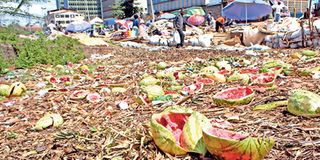Here is what consumers can do to have safe food

Decaying watermelons at the Wakulima Market in Nairobi.
What you need to know:
- People hardly pay attention to package labels that bear important parameters such as food composition, quality indicators and symbols of quality systems compliance with food safety standards or traceability.
- It’s time, therefore, we reflected and acted on the negative effects of unsafe food. In dairy, aflatoxin M1, hydrogen peroxide, residues from use of veterinary drugs, zoonotic diseases and use of formalin are some glaring issues of concern.
- Most importantly, consumers are the greatest asset for behaviour change. By fostering a culture of demanding safe food, they will make food safety needs to be adapted in the markets.
- Holistically, better management of food safety would significantly contribute to achieving the Big Four Agenda and multiple sustainable development goals, especially those related to poverty, hunger and well-being.
Most consumers when buying food often base their decisions on cost and perceived quality, usually checked by the product’s visual appearance.
On supermarket or grocery shelves, presentation of food products, offers and advertisements mostly influence buyers’ decisions.
People hardly pay attention to package labels that bear important parameters such as food composition, quality indicators and symbols of quality systems compliance with food safety standards or traceability.
The United Nations General Assembly declared that June 7, starting this year, would be World Food Safety Day to celebrate the countless benefits of safe food.
It’s time, therefore, we reflected and acted on the negative effects of unsafe food. In dairy, aflatoxin M1, hydrogen peroxide, residues from use of veterinary drugs, zoonotic diseases and use of formalin are some glaring issues of concern.
In horticulture, previous research has revealed pesticide residues in fruits and vegetables sold in the domestic market.
All this has led to negative implications on the health of consumers particularly vulnerable population groups such as pregnant women, children, elderly citizens and those with weakened immune systems. The big question is: how should consumers be responsible or get involved in food safety, which is a shared responsibility?
Interventions by governments, donors, development agencies, food safety experts and researchers require the consumer to play a leading role in ensuring food is safe.
Nothing good comes for a lesser penny. Consumer willingness to pay top prices is a big motivator for food vendors to supply and stock safer foods.
ACHIEVING THE BIG 4
Premium prices will help consumers front for traceability of food and push for safety regulations.
Traceability in the domestic market will create integrity in the supply chain and ensure safety and quality of the food. It will arrest possible malpractices like deliberate mislabelling of food products for the sake of high sales.
Most importantly, consumers are the greatest asset for behaviour change. By fostering a culture of demanding safe food, they will make food safety needs to be adapted in the markets.
Consequently, creating demand-driven markets rather than supply-driven gives food business operators the limited option of complying with consumer needs instead of viewing it as harassment by authorities enforcing food safety regulations.
Even after accessing safe food, contamination can still occur, yes, in your home. Embracing prevention measures and putting high-level hygiene under your control are key levellers in handling and preparing the food in a safe-to-eat manner.
Holistically, better management of food safety would significantly contribute to achieving the Big Four Agenda and multiple sustainable development goals, especially those related to poverty, hunger and well-being.
In conclusion, there comes a time when you must choose between continuing to open a page or simply closing the book.
The voice of consumers can be too loud to go unnoticed. Together, let’s identify and implement corrective actions to the existing and emerging threats of unsafe food and make food chain actors adapt to a changing environment.
The writer works at Micro Enterprises Support Programme Trust’s AgriFI Food Safety programme.





